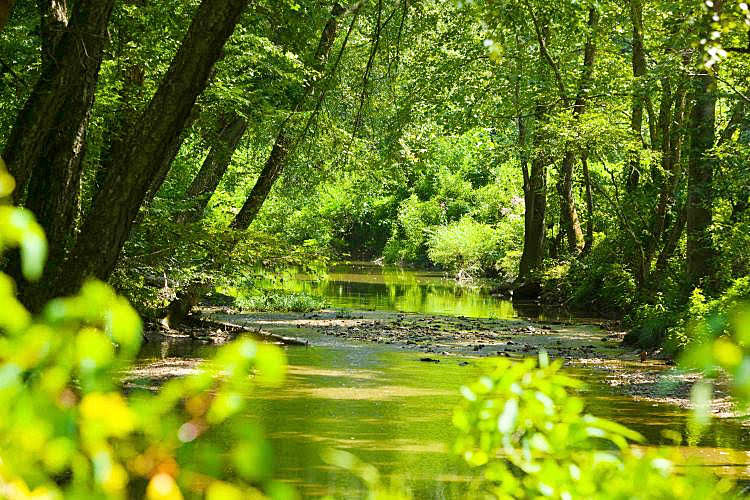Kentucky land conservation fund gets ‘new lease on life’ from lawmakers
Published 5:11 pm Thursday, April 25, 2024

- (Photo by Matt Barton, UK Agricultural Communications)
By Liam Niemeyer
Kentucky Lantern
Over the past three decades, a state-managed fund has been a financial force behind the creation and expansion of parks, nature preserves and hunting grounds across Kentucky.
The Kentucky Heritage Land Conservation Fund, established in 1990 to provide a consistent source of funding for local governments, state agencies, nonprofits and universities to protect land for recreation and preserving wildlife, has put into conservation more than 95,000 acres across the state.
The fund helped add 118 acres to a local park in Lincoln and Garrard counties. It helped conserve threatened and endangered species of plants on state-owned nature preserves, including the white fringeless orchid in Southeastern Kentucky. And it helped Western Kentucky University purchase and protect the entrance to a cave featuring Native American drawings dating back to 80 B.C.
Zeb Weese, the former executive director of the Kentucky Office of Nature Preserves and a consultant for the Kentucky Lands Trusts Coalition, said funding from the conservation fund has also significantly grown the size of Natural Bridge State Resort Park.
“When you go to Natural Bridge, you hike around, you think that it’s forest as far as the eye can see, and it is. But a lot of that was private land that came up for sale.” Weese said. “Folks enjoy the parks in their area, but they don’t necessarily know (the) heritage land fund was part of it.”
But in the past 15 years, the funding sources for the conservation fund dwindled for a number of reasons. Revenue the fund receives from an unmined mineral tax on coal has cratered with the decline of the coal industry. Monies received from fines levied by state environmental regulators are inconsistent, and funding collected from the sale of certain vanity license plates has also declined.
Weese said at least $15.5 million of revenue had also been swept from the fund in past state budgets, zapping it of the annual revenue that it is supposed to statutorily receive. Weese said the fund went from conserving thousands of acres each year in the early 2010s to just conserving a little over one acre of Wolfe County land in fiscal year 2023.
Those sitting on the board overseeing the conservation fund say they’ve seen fewer applications to fund land conservation in recent years, and some past projects have had to be put on hold to wait for funding to become available.
Weese said the budget sweeps from the fund have stopped the past couple of years, and environmental advocacy groups such as the Kentucky Conservation Committee wanted this year’s state budget to replenish the more than $15 million swept from the fund in the past by tapping into billions of dollars in the state’s rainy day fund.
Lawmakers ultimately allocated two million dollars to the fund, which while less than what advocates wanted, could still provide more opportunities for conservation projects.
“It’s a new lease on life,” said Hugh Archer, the vice-chair of the conservation fund’s board and past commissioner of the Kentucky Department of Natural Resources. “It’s really important that we fund these things today while they’re available and are affordable to the citizenry, and what we’re preserving is things like biological diversity.”
Archer, who has served on the board under various governors, said it can take a while to develop and build trust with landowners, which makes having funds available important for when a land deal finally does go through. Funding can also be used to match federal grants toward conservation projects, making the fund’s dollars go even further.
Sen. Matthew Deneen, R-Elizabethtown, who advocates point to as instrumental in getting the $2 million allocated to the fund, told the Lantern he views the money as a boon for economic development and the health of Kentuckians by creating greenspaces, parks and trails that can benefit growing Kentucky communities.
“The heritage land trust fund is just a piece of that puzzle that has been missing, and we need to fill that void and make sure that it’s there and secure as we grow the state,” Deneen said. “When you have these amenities, it helps attract people here. What’s the closest park?”
Deneen said he realizes $2 million is not much funding, but he believes it’s a start. He’s hopeful that local governments in particular that lack local funds can take advantage again of the conservation fund to expand and create new parks.
“You don’t have to be some extreme environmentalist to appreciate what these amenities can bring to a community,” Deneen said.
As for addressing how to tackle diminished revenue sources from coal mineral taxes in the future, those who work for the conservation fund say it’s an ongoing conversation that Kentucky lawmakers would need to change.
Zach Couch, the current executive director of the Kentucky Office of Nature Preserves who sits on the conservation fund board, said those on the board plan to put the funding to “good use,” something that can be an asset for his office in protecting species that are declining but not federally listed as endangered or threatened under the Endangered Species Act.
He said much of Kentucky’s land is still privately owned and will likely remain that way; 88% of Kentucky’s forests are privately owned, according to the Kentucky Division of Forestry. Couch said the fund provides investments toward preserving natural spaces for land owners willing to sell.
“The best way to prevent the need for listing those species is to manage them now, and a big part of that is through land acquisition, protecting their habitat, protecting the actual population,” Couch said. “By doing this work, it’s a small investment that pays off dividends that allows for continued development and economic development of the state.”






